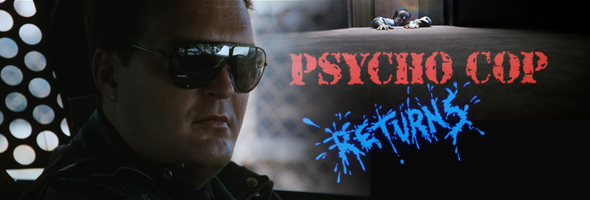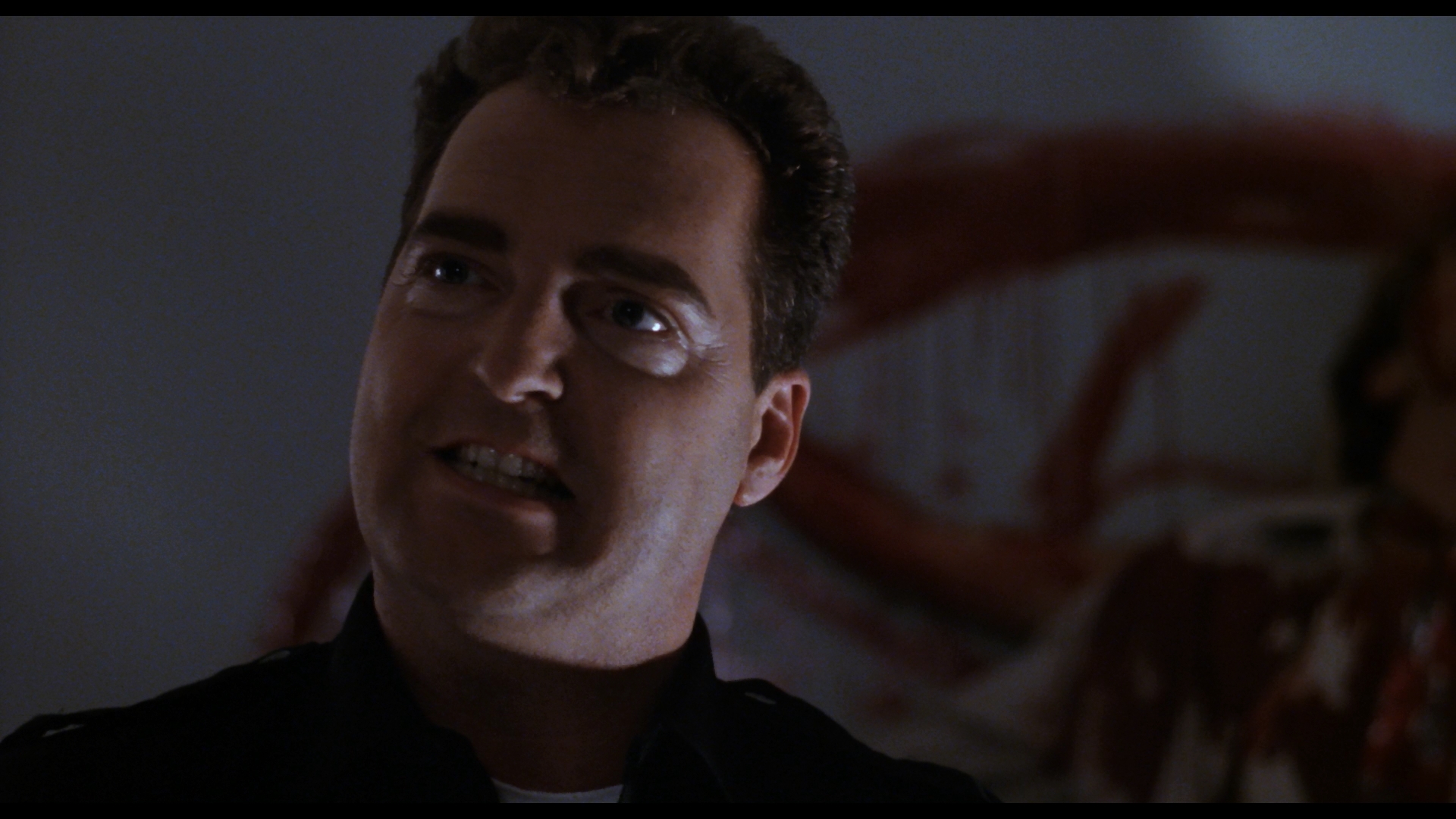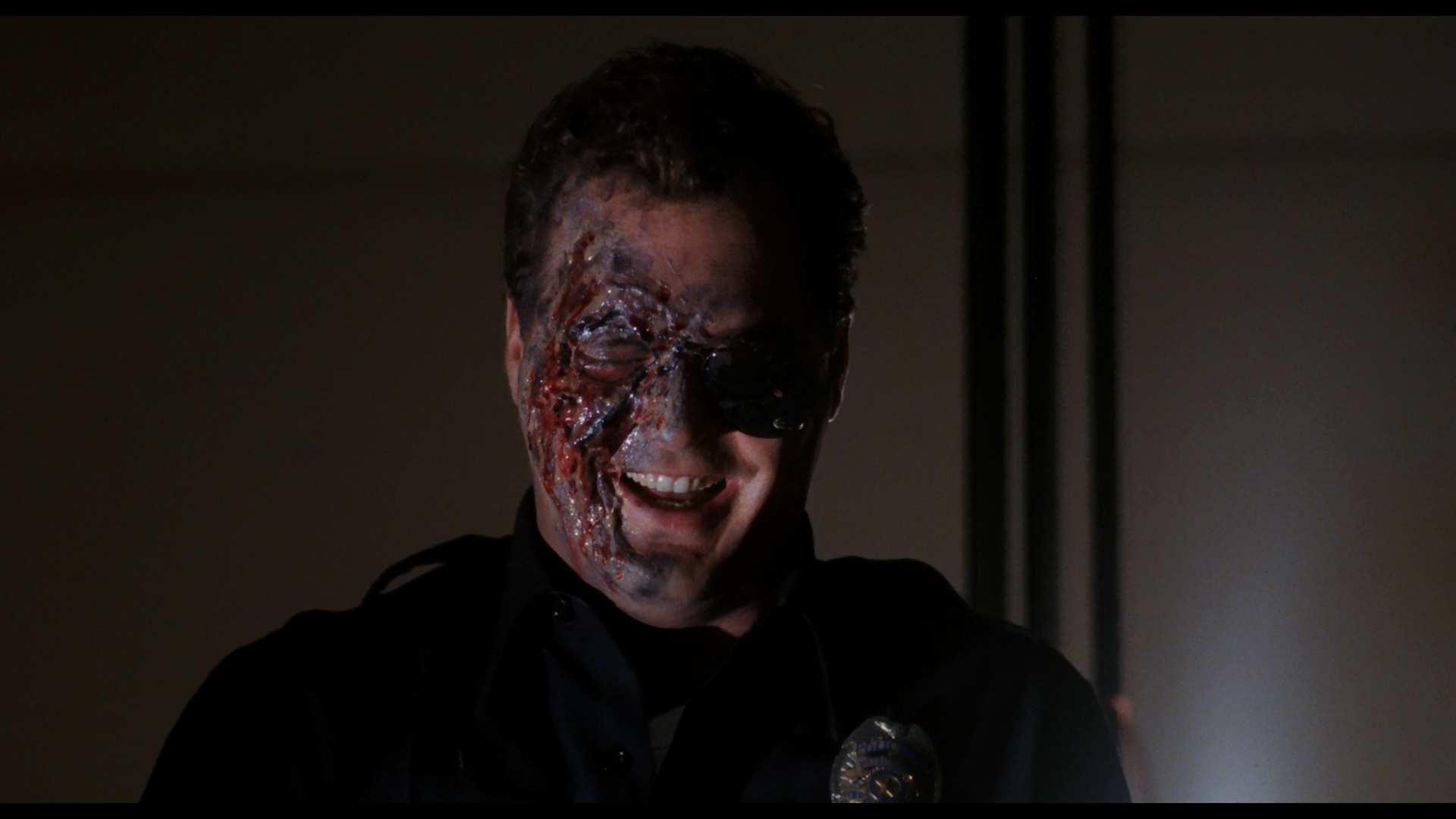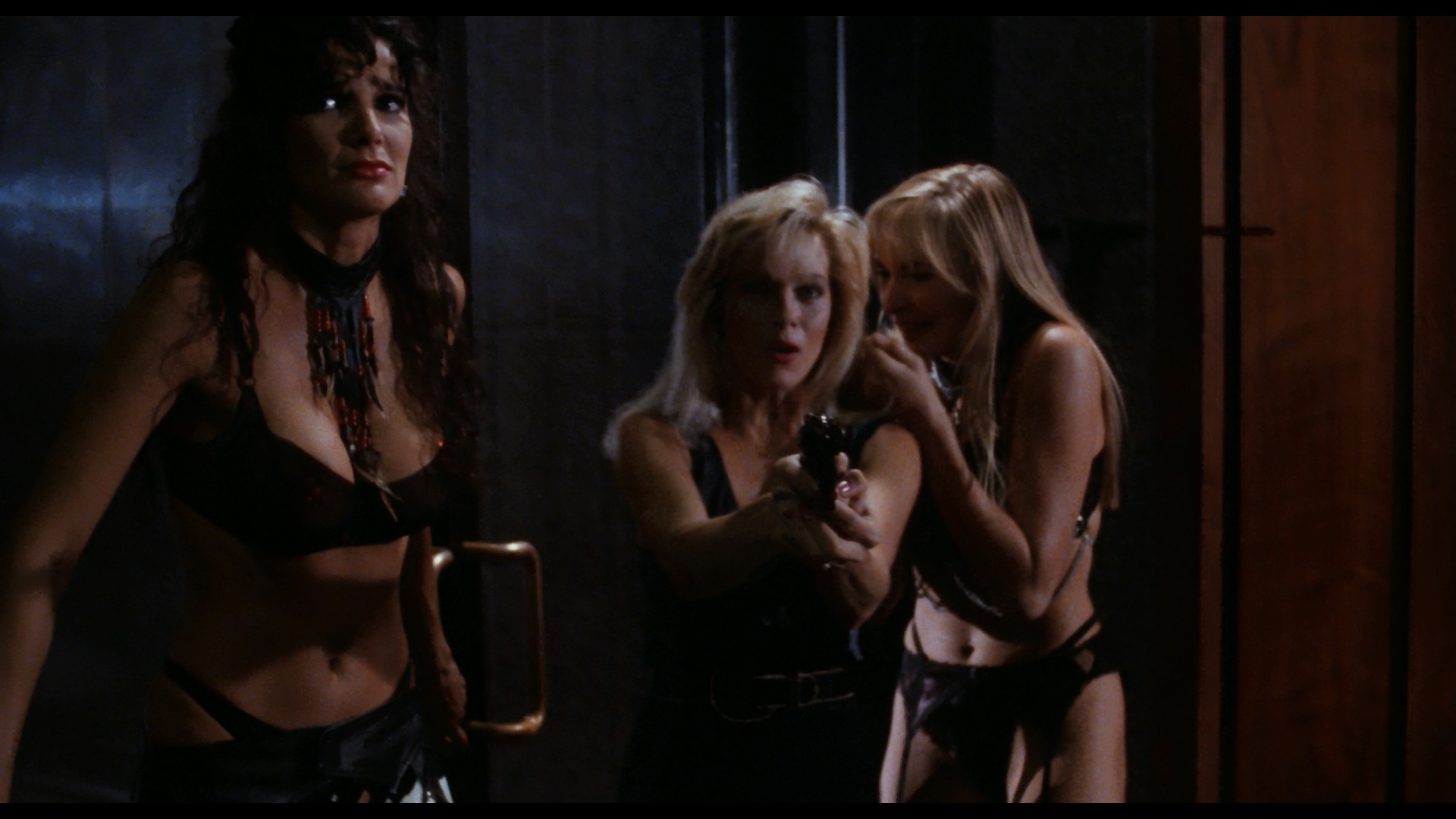

Color, 1993, 85 mins. 13 secs.
Directed by Adam Rifkin (“Rif Coogan”)
Starring Starring Robert B. Shafer, Barbara Niven, Rod Sweitzer, Miles Dougal, Nick Vallelonga, Dave Bean, John Paxton, Julie Strain
Vinegar Syndrome (Blu-ray & DVD) (US R0 HD/NTSC) / WS (1.85:1) (16:9), Allumination (DVD) (US R1 NTSC)

 The rush of direct-to-video horror movies in the height of VHS mania in the late ‘80s and early ‘90s led to some utterly bizarre low-budget curious, many of which spawned sequels if they managed to land more than one copy in video stores across the United States. Case in point: Psycho Cop, a junky 1989 slasher film released by Southgate that charted the murderous exploits of devil-worshiping supernatural cop Officer Joe Vickers (frequent sitcom guest star Shafer, billed as “Bobby Ray Shafer”). The film was clearly intended to ride the coattails of the previous year’s Maniac Cop, so a sequel alternately known as Psycho Cop Returns and Psycho Cop II was put into motion a few years later. Weirdly, directorial reins were handed over to Adam Rifkin, who had scored an unlikely high-profile RCA/Columbia release for his attempted midnight movie The Dark Backward and somehow scored a modest Blockbuster Video staple with the Traci Lords comedy, The Nutt House (which is most notorious for having the Raimi brothers involved in its creation before they had their names removed from the finished product). Rifkin (who went on to helm Giuseppe Makes a Movie) was nurturing an alter ego directorial persona at the time called Rif Coogan, a down-and-dirty purveyor of T&A and cheap horror fare introduced in 1990 as the helmer of the ridiculous Republic Pictures release, The
The rush of direct-to-video horror movies in the height of VHS mania in the late ‘80s and early ‘90s led to some utterly bizarre low-budget curious, many of which spawned sequels if they managed to land more than one copy in video stores across the United States. Case in point: Psycho Cop, a junky 1989 slasher film released by Southgate that charted the murderous exploits of devil-worshiping supernatural cop Officer Joe Vickers (frequent sitcom guest star Shafer, billed as “Bobby Ray Shafer”). The film was clearly intended to ride the coattails of the previous year’s Maniac Cop, so a sequel alternately known as Psycho Cop Returns and Psycho Cop II was put into motion a few years later. Weirdly, directorial reins were handed over to Adam Rifkin, who had scored an unlikely high-profile RCA/Columbia release for his attempted midnight movie The Dark Backward and somehow scored a modest Blockbuster Video staple with the Traci Lords comedy, The Nutt House (which is most notorious for having the Raimi brothers involved in its creation before they had their names removed from the finished product). Rifkin (who went on to helm Giuseppe Makes a Movie) was nurturing an alter ego directorial persona at the time called Rif Coogan, a down-and-dirty purveyor of T&A and cheap horror fare introduced in 1990 as the helmer of the ridiculous Republic Pictures release, The  Invisible Maniac. The enigmatic Mr. Coogan returned for Psycho Cop Returns, which stands alone from its predecessor
Invisible Maniac. The enigmatic Mr. Coogan returned for Psycho Cop Returns, which stands alone from its predecessor  perfectly well and may be one of the weirdest slasher films of its era. Next to 1990’s Hard to Die, it may also be the most ridiculous film of the decade set inside an office building.
perfectly well and may be one of the weirdest slasher films of its era. Next to 1990’s Hard to Die, it may also be the most ridiculous film of the decade set inside an office building.
 R-rated cut that ditched most of the highlights. What was left was still plenty outrageous in terms of plotting and dialogue (not to mention the borderline slapstick comedy music score at times), but this is really a film to be viewed full strength to get the best effect. None of the acting is “good” in any kind of traditional sense, but the actors all clearly know what kind of film they’re making and perform with tongues firmly in cheek. Obviously Shafer gets to do this the most with his methodical and very dedicated lawman making off with the best moments, but as far as body count movies go, this one is fully aware of its own absurdity and run with it as far as the limits of taste will allow.
R-rated cut that ditched most of the highlights. What was left was still plenty outrageous in terms of plotting and dialogue (not to mention the borderline slapstick comedy music score at times), but this is really a film to be viewed full strength to get the best effect. None of the acting is “good” in any kind of traditional sense, but the actors all clearly know what kind of film they’re making and perform with tongues firmly in cheek. Obviously Shafer gets to do this the most with his methodical and very dedicated lawman making off with the best moments, but as far as body count movies go, this one is fully aware of its own absurdity and run with it as far as the limits of taste will allow. as a participant in "Habeas Corpus" (42m46s), a collection of cast and crew interviews also featuring Shafer, Dougal, Sweitzer, Vallelonga,
as a participant in "Habeas Corpus" (42m46s), a collection of cast and crew interviews also featuring Shafer, Dougal, Sweitzer, Vallelonga,  actresses Barbara Niven and Melanie Good, screenwriter Dan Povenmire, and editor Peter Schink. Between the two Rifkin chats quite a bit about how he came up with his nom de sleaze, picking a talented cast and flying some members in with various roles switched around along the way, hallucinating during one scene due to extreme sleep deprivation, and even shooting most of the film at a Burbank office building that now serves as the headquarters for The Cartoon Network. The other participants are full of stories as well involving a Bart Simpson drawing, which cast members thought they were playing it straight, the various romantic and marital connections of the actors, and the complications of shooting mostly at nights. And yes, they talk quite a bit about staging the Rodney King scene, too. In "The Victims of Vickers" (9m32s), special effects artist Mike Tristano chats about his fondness for the film (including the remarkable fact today that it was shot with two 35mm cameras despite its nickel-and-dime budget), his admiration for Rifkin, and his shocked reaction when he first laid eyes on the R-rated cut that threw away most of his handiwork.
actresses Barbara Niven and Melanie Good, screenwriter Dan Povenmire, and editor Peter Schink. Between the two Rifkin chats quite a bit about how he came up with his nom de sleaze, picking a talented cast and flying some members in with various roles switched around along the way, hallucinating during one scene due to extreme sleep deprivation, and even shooting most of the film at a Burbank office building that now serves as the headquarters for The Cartoon Network. The other participants are full of stories as well involving a Bart Simpson drawing, which cast members thought they were playing it straight, the various romantic and marital connections of the actors, and the complications of shooting mostly at nights. And yes, they talk quite a bit about staging the Rodney King scene, too. In "The Victims of Vickers" (9m32s), special effects artist Mike Tristano chats about his fondness for the film (including the remarkable fact today that it was shot with two 35mm cameras despite its nickel-and-dime budget), his admiration for Rifkin, and his shocked reaction when he first laid eyes on the R-rated cut that threw away most of his handiwork.